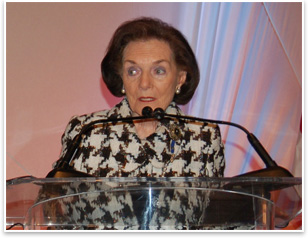
Frances Hesselbein Calls for Leadership at Grassroots by Russell Boniface
“Serving the way you are serving is a calling,” Hesselbein told attendees. “We are called at this moment to redesign a society. Everyone in this room is a leader of the future, and we have to define leadership for ourselves on our own terms.” Hesselbein called on the AIA to undertake a leadership imperative. “Leading well is the best gift architects can give back to society.” She pointed out that leadership is a matter of how to be, not how to do. “We spend most of our lives learning how to do, and teaching other people how to do, yet in the end it’s the quality and character of the leader that determines results.” No time for nostalgia; leadership for a changing social sector The Grassroots session reflected the destiny of the AIA, Hesselbein noted. “It’s the destiny of a great Institution, the destiny of an indispensable partnership of great professional leaders. I am deeply honored to be joining the inspired architects of our country in a powerful partnership. Trust and mutual respect are palpable in this room. Peter Drucker called the nonprofit sector the social sector because that is where we meet the social needs of our people. Your example can help the nonprofit, social sector see itself life-size.” Hesselbein underscored her call for social change through partnerships by revealing that recent studies show 50 percent of U.S. children will not receive a high school diploma—500,000 children in New York City alone. “These are not invisible children. To the people of the AIA and our associates, these are our children. We cannot sustain a democracy if we do not educate all these children. Who in our society will light that fire? You and I know the answer. Our organization is going to find partners who will light that fire because the day of partnership is upon us. We would like to share what we have and what we are with the AIA.” Diverse organization of values; think outside the boxes A diverse, circular organization is an important goal for the AIA to continue to pursue to send a powerful message, she added. “Remember the little guy who sat at the top of the pyramid, looking down at his people?” Hesselbein asked. “And they looked up. That hierarchal boxed system is gone forever. We need to disperse leadership right across the organization. You and I have the courage to change the tired, old hierarchal boxed system in favor of a flexible, fluid circular management system of the future. We can develop leaders at every level.” Building alliance to address diverse communities “I think you and I share this mission. I have a sense of urgency that I think architects share. We have to build a community outside the walls as energetically as we build an organization within the walls. All of us share the responsibility to change lives, to move from success to significance. Providing equal access to opportunity, growth, education, and development is a shared leadership imperative in a diverse population. The day of the Lone Ranger is over.” A journal and a torch Hesselbein closed by quoting playwright George Bernard Shaw, who wrote that life belongs to the whole community, and that life is a splendid torch to burn as brightly as possible. “Ten years from now,” Hesselbein concluded, “when the history of this great American Institute of Architects is written about your work, practice, and community engagement and collaboration, may they write of you: ‘They held a splendid torch. The future called, and they responded.’”
|
||
Copyright 2008 The American Institute of Architects. All rights reserved. Home Page |
||
home
news headlines
practice
business
design
recent related
› Accent on Architecture Gala Honors the Best and Brightest
› Members Share Insights, Issues with the Architects of the 21st Century Workplace Renovation
› Meet the 2009 Candidates for AIA Office
Visit the Leader to Leader Institute Web site
You can subscribe to the organization’s free weekly Innovation of the Week e-newsletter.

 Summary:
Summary: